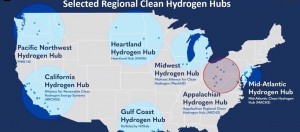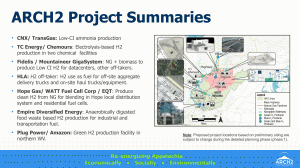From an Article by Brad McElhinny, WV Metro News, October 29, 2023
An Appalachian hydrogen hub, which made a splash this month when the region was selected for nearly a billion dollars in federal support, is still a work in progress. The early vision for the hub sprawls across West Virginia and Appalachian communities in surrounding states with interconnected pieces to produce hydrogen power, store carbon dioxide emissions and use the hydrogen power for activities like transportation or data storage.
But even the highest-level supporters of the project aren’t yet ready to say exactly what it will be like. “The hydrogen hub really offers us, as West Virginia, the opportunity to continue to be powering the nation and is also where the innovation is going to be occurring,” Senator Capito said during a news briefing with state reporters.
“These nodes that they talk about — that’s why I think it’s exciting for our state: it’s not just going to be concentrated in one specific area. It will offer us opportunities to develop hydrogen for uses in power, in advanced manufacturing, in heavy-duty transportation and, in my understanding from some of my initial conversations, in some of the chemical making.”
For example, Capito took note of early plans for the Chemours site at Washington Works in Wood County to develop electrolysis-based hydrogen production — providing power to the plant and possibly for others in the area. A similar idea is likely to take shape at the Chemours site at Belle, Kanawha County.
“They are looking forward to transforming some of their manufacturing from natural gas to hydrogen so we have a ready customer right there that has proven technologies. I think that gives us an idea of what our future could be here in terms of where the uses are. In terms of the process, it is a lengthy process.”
Planners this past week described a key distinction: although the project has been selected by federal officials for further advancement, it has not yet been approved. Approval is likely to occur early next year, leading then to a detailed plan process of 12 to 18 months.
“So selected applicants are just now exiting the application phase and entering into a period of negotiation that will take months to finalize. And during this negotiation period, applicants will refine their proposals further and better define plans, including those for community benefits,” said Lydia Kubiak-Cardona, a community engagement specialist with the U.S. Department of Energy’s Office of Clean Energy Demonstrations.
That means the hub — and the economic projects that encompass it — will move and shift somewhat over the next few years.
President Joe Biden and officials with the U.S. Department of Energy on Oct. 13 announced the Appalachian hydrogen hub and six similar projects across the nation. The total federal support is $7 billion, with the Appalachian project in line for $925 million of that. Private investment is already lining up and will put up billions more in financial support.
During an initial background session for reporters, senior Biden administration officials described production nodes in Belle in Kanawha County, Follansbee in Brooke County, Washington in Wood County, Point Pleasant in Mason County and Fairmont in Marion County.
In a followup session with Senate Energy Chairman Joe Manchin, D-Monongalia, and U.S. Energy Secretary Jennifer Granholm, officials said the ARCH2 hub will be headquartered in Morgantown.
Appalachian counties in Ohio and Pennsylvania are also participating in the hub. Officials said the project is geared toward the rich supplies of natural gas in the region, although some aspects of the project also rely on producing “green hydrogen” from renewable sources.
That’s the broad picture for the time being — although not exactly overflowing with detail. During a livestreamed community briefing this week, project developers said that as the hub now moves toward full approval some aspects of the participation could change.
“I want to emphasize that we’re at the very beginning of a long process,” said Suzy Baker, the engagement lead for the hub projects. “These hubs are going to take many years to come to fruition and will have to pass through several stages before any construction activities can start.”
Broadly, the hub includes both “green hydrogen” and “blue hydrogen” producers, natural gas pipelines, below-surface carbon dioxide injector storage and more. Some locations are labeled as “plug power” for heavy-duty transportation fuel stations.
“We wanted to put together a proposal that represented the communities, the companies and really different end uses,” said Shawn Bennett, division manager for energy and resilience at Battelle, one of the companies at the center of the hydrogen hub’s development.
“When you think about the large scale of this opportunity, we’ve brought in a lot of great partners.”
Maps that the developers showed during the presentation depicted:
>>> a CNX/Transgas ammonia production facility in southern West Virginia: “With what’s happening with Russia’s invasion of Ukraine really exacerbating fertilizer prices, ammonia prices, this is an opportunity for us to reshore a lot of that pneumonia,” Bennett said.
>>> two TC Energy/Chemours facilities around the Kanawha Valley to produce hydrogen through electrolysis: “So really transitioning to a low-carbon intensity retrofit for powering their chemical facilities,” Bennett said.
>>> a Fidelis/Mountaineer Gas “GigaSystem” site in the mid-Ohio Valley to use natural gas and biomass to produce hydrogen for data centers and other consumers: “Just a huge investment here, looking at producing low-carbon intensity hydrogen for data centers and other off-takers in the region,” Bennett said. “Really, it’s a pure hydrogen producer.”
>>> a Hog Lick Aggregates site in north central West Virginia to use hydrogen to fuel delivery trucks, haul trucks and equipment: “They’re decarbonizing the mining sector there,” Bennett said, “by retrofitting their trucks to run on hydrogen instead of diesel.”
>>> a Hope Gas/WATT Fuel Cell Corp/EQT location in central West Virginia to produce hydrogen from natural gas for Hope’s local distribution system and residential fuel cells: “So finding those communities who may have electricity that kind of goes in and out,” Bennett said, “providing them an opportunity for backup power — something that is reliable and something they can use all the time.”
>>> an Empire Diversified Energy site at the tip of the Northern Panhandle producing hydrogen through anaerobically-digested food waste for industrial and transportation fuel:”They’re using anaerobically digested food waste for hydrogen production.”
>>> and a Plug Power/Amazon site in northern West Virginia to produce “green hydrogen” “This is a project that is up near Weirton, producing green hydrogen in a production facility and then partnering with Amazon and powering their trucks for over-the-road trucking and long-distance trucking.”
But the slide showing that potential development also warned: “Proposed project locations based on preliminary siting are subject to change during the detailed planning phase.”



{ 1 comment… read it below or add one }
Environmentalists raise concerns about hydrogen hub plans
From an Article by Joseph Pete, Northwest Indiana Times, October 30, 2023
Indiana scored a share of a $1 billion Midwest hydrogen hub that’s expected to bring hydrogen production to the BP Whiting Refinery and help local industry reduce carbon emissions.
The Midwest Alliance for Clean Hydrogen, or MachH2, hub backed by Indiana, Illinois and Michigan was one of seven bids to win a share of $7 billion in federal funding meant to scale up hydrogen production as a way to help-hard-to-decarbonize industries shrink their greenhouse gas emissions. The hydrogen hub project is estimated to reduce an estimated 25 million metric tons of carbon dioxide emissions or about the same as 5.5 million gas-powered cars while sparking significant economic development.
But environmental groups have concerns. Environmentalists have expressed skepticism and voiced support for green hydrogen made only with renewable energy sources.
“Fossil fuel-produced hydrogen and carbon capture and storage will irrevocably endanger the Great Lakes ecosystem while further harming the region’s already overburdened communities,” said Susan Thomas, director of legislation and policy/press at Just Transition Northwest Indiana. “As a historic steel hub, Northwest Indiana is an epicenter in the fight for a Just Transition to renewable energy. We deserve the right to green jobs and a healthy environment, not more false solutions. These Hydrogen Hub announcements are more of the same carbon schemes from corporate polluters.”
Former State Rep. Chris Chyung, executive director at Indiana Conservation Voters, has had concerns about a lack of transparency and that MachH2 only held one public meeting with Northwest Indiana, which resulted in few answers.
“Local environmental, racial justice and faith leaders must be included in discussions that will make or break Indiana’s industrial and clean energy future,” said Chyung, executive director at Indiana Conservation Voters. “Now we have a plan that, if implemented wrongly, will deepen our state’s dependence on polluting fossil fuels and add new, dangerous infrastructure in already overburdened communities.”
Hydrogen is being touted as a substitute for coal for blast furnaces, half of which is concentrated in Northwest Indiana. BP is looking to start producing hydrogen to help local steel mills and other factories make progress toward net zero emissions, while also exploring carbon capture and sequestration.
A recent Sierra Club report found that Gary Works, Cleveland-Cliffs Burns Harbor Works and Cleveland-Cliffs Indiana Harbor Works were the three worst carbon emitters in the country.
The study found steel industry pollution contributed to an estimated 900 and 2,000 excess deaths a year, as well as 30,000 incidences of respiratory symptoms.
“Our recent report was a powerful reminder that the environmental and health consequences of the steel industry demand our immediate attention and action,” said Joab Schultheis, energy committee chair of Sierra Club’s Hoosier Chapter. “We must chart a course toward cleaner, more sustainable steel production practices for the sake of our planet, communities, steel workers, and future generations.”
The Delaware Riverkeeper Network in the Philadelphia area, where the Mach 2 Hydrogen Hub landed $750 million in federal funds to operate in the Delaware River, has concerns that hydrogen was a boondoggle that would benefit the fossil fuel industry and perpetuate the use of fossil fuels. It raised concerns about the expense of hydrogen production, how much water it would use, how hot it burns and how it poses a risk of explosions.
“The last thing the Delaware River Watershed needs is the development of hydrogen and the pollution it will bring. The Delaware River Valley already doesn’t meet minimum federal clean air standards and our communities cannot tolerate one more molecule of the pollutants that plague us. Delaware, Pennsylvania and New Jersey must aggressively move to drastically reduce greenhouse gas emissions, not add to them through the proposed Mach 2 hub that the federal government is funding,” said Tracy Carluccio, deputy director of the Delaware Riverkeeper Network.
The steel industry currently accounts for between 7% to 9% of greenhouse gas emissions, according to studies. The steel industry is pursuing many paths toward decarbonization, including hydrogen, carbon capture, cleaner direct reduced iron feedstore and more electric arc furnaces.
Other environmental groups like the Minneapolis-based Great Plains Institute are hopeful the hydrogen hubs could put a serious dent in carbon emissions from industries like integrated steelmaking and aviation that are harder to decarbonize due to current technological limits.
“The announcement of federally supported hydrogen hubs launches a new opportunity to equitably build a clean hydrogen economy, and GPI looks forward to working with the new hubs to accelerate decarbonization across the economy,” Great Plains Institute President and CEO Rolf Nordstrom said. “GPI is working to enable the development of a robust and equitable clean hydrogen economy to expand our nation’s portfolio of options for decarbonizing some of the hardest-to-decarbonize sectors, such as agriculture, heavy industry and parts of the transportation sector.”
SOURCE: https://www.nwitimes.com/news/local/environmentalists-raise-concerns-about-hydrogen-hub-plans/article_870cd82a-7518-11ee-9a43-8f82a9ff406a.html